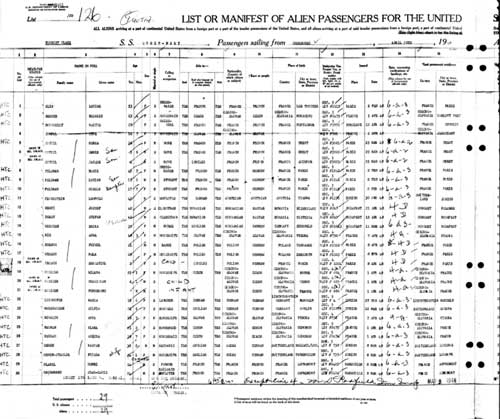I Know the Girl in That Photo!
What are the odds of finding a 60-year-old photo of your ancestor arriving at Ellis Island? If the photo was nothing more than half a page from an unidentified magazine, what are the chances of tracking it down?
Some time ago, Yitz Twersky of New York found a page torn from a magazine showing his mother-in-law, Ernestine, two years old at the time, with her parents at Ellis Island. While this was exciting, there was no information which magazine it appeared in.
However, Twersky noticed tiny print alongside the picture that identified the photographer: Ollie Atkins. As Mr. Twersky soon discovered, Ollie Atkins was a big name in photography — a renowned photojournalist who took award-winning photos of history makers like Truman; Martin Luther King, Jr.; Richard Nixon and others. In fact, Atkins served for several years as the White House photographer.
The search for Ollie Atkins led to a repository of the photographers’ work at George Mason University. Fortunately, Atkins was a meticulous record-keeper, who kept exhaustive lists of his work. The curators at the Atkins collection identified Mr. Twersky’s photo as one that accompanied a 1949 article in The Saturday Evening Post, entitled “They Do Anything to Get Into the U.S.A.”
Twersky was over the moon. The archivist could practically hear him leaping for joy over the phone. How did his mother-in-law react? “She was crying,” Twersky told us. “I went online and found an old copy of January 29, 1949, Saturday Evening Post so she would have the original issue.”

Courtesy of Yitz Twersky
Mr. Twersky even e-mailed us a copy of the ship’s manifest from 1948 that his in-laws had kept all these years, showing Rabbi Feiwel Kresch as number sixteen on the list, with his wife Mala and tiny Ernestine (our reader’s future mother-in-law) listed below him. “This is the document that’s in front of the official in the photo,” Mr. Twersky informed us.
Little Ernestine’s parents had escaped Nazi-run Poland, eventually surviving an arduous journey to France. The Post article, (link below) shares many stories, humorous to pitiable, about what immigrants would do to beat the quotas and gain admittance to American soil. But Mr. Twersky’s tale gave us a new slant as to why people were so desperate. As tragic as WWII Europe was, the post-war years were brutally bleak as well. The U.S. was still determined to keep out “undesirables,” and post-war Europe was hoping to avert the next war by insisted displaced people return to their homeland, no matter how unhealthy that would be for them.
The few who managed to reach America found that the quota set for their country had already been filled. Men of the cloth were among the exceptions to the quotas, so Rabbi Kresch and his family were duly admitted. Below is a photo of Ernestine today, a pretty lady with her own grandchildren.

Photo courtesy of Yitz Twersky
The 1949 article was by James McFarland, an American visa official who had the often unenviable task of permitting or denying admittance to the U.S. “I have nursed my aching ears against a babel of foreign tongues, have intervened in fist fights and pacified drunks,” he wrote of his job. “I have joggled wailing babies on my knee, have fended off bribes and turned a chill eye to the lures of female charmers.” He concluded that “on occasion I have been shocked and disillusioned. But I have also been genuinely touched and inspired by the sincerity and resoluteness of purpose of a host of Europeans, Asiatics, Latin Americans and our good neighbors to the north, the Canadians, who want to become American citizens.”
With immigration a hot issue today, it is worthwhile to read how generations of immigrants have always struggled to enter America.
We thank Yitz Twersky and family for sharing their tale and giving us the opportunity to help them fill a gap in their family’s chronicle.
![]() Read “They Do Anything to Get Into the USA,” by James McFarland. Published January 29, 1949.
Read “They Do Anything to Get Into the USA,” by James McFarland. Published January 29, 1949.